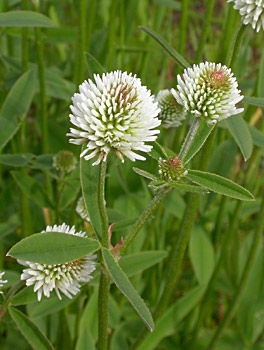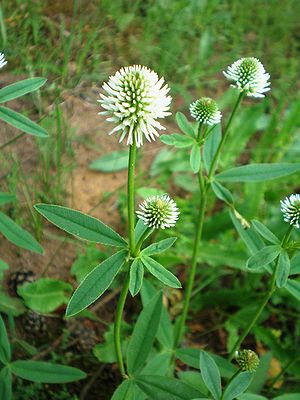Trifolium montanum
Mountain clover ( Trifolium montanum )
The mountain clover ( Trifolium montanum ) is a species in the subfamily of the Fabaceae ( Faboideae ) within the legume family ( Fabaceae ). It is distributed in Eurasia.
Description
The mountain clover grows as a deciduous, perennial herbaceous plant and usually reaches stature heights of 15 to 40 centimeters. The upright stem is along its entire length woolly hairs ( trichomes ). At the bottom of the rosette of leaves is covered from the remains of old leaf sheaths.
The pinnate leaves consist of three leaflets. The spiny toothed leaflets on the edge are hairy oblong- lanceolate and on the bottom. The stipules are ovate and pointed.
The main flowering period is in the months of May to July. Usually there are two little head like inflorescences that can reach a diameter of 15 to 20 millimeters usually on a stalk. The flower stalk is about 1 millimeter long. The hermaphrodite flowers are zygomorphic and fünfzählig double perianth. The pfriemlichen and just outstretched cup teeth are nearly equal in length and as long as or slightly longer than the ten annoying calyx tube. The 7-9 mm long crown is white to yellowish-white. After withering the corolla is reddish- gray brown.
Fruit ripening begins in August. The legume is usually one seed.
Ecology
The mountain clover is a Hemikryptophyt.
Pollination is by bees relatives as well as by day and moths.
The diasporas are subject to intestinal and random dispersal by grazing animals.
Occurrence
The mountain clover occurs in central and southern Europe. East of it penetrates to West Siberia, the Caucasus and Iran before. The mountain is one among the clover Trifolium species in Central Europe the most widely used.
In Germany the mountain clover is common in the central and southern part, in the north and northwest it is completely absent in the rule. In Austria and Switzerland, Trifolium montanum is found quite frequently.
The mountain clover grows in semi-arid grassland and dry grassland communities. He usually prefers warm, often clayey and humic Kalklehmböden.









.JPG)